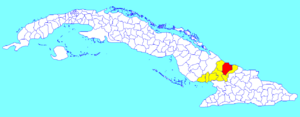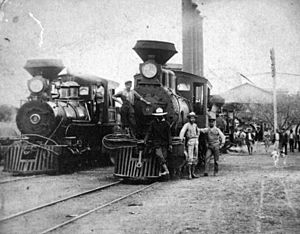Puerto Padre facts for kids
Quick facts for kids
Puerto Padre
|
|
|---|---|
| Nickname(s):
City of Mills, La Villa Azul de Cuba (Cuba's Blue City)
|
|
| Motto(s):
Praesto Pro Patria
|
|

Puerto Padre municipality (red) within
Las Tunas Province (yellow) and Cuba |
|
| Country | Cuba |
| Province | Las Tunas |
| Established | 1541 (1861 as a city) |
| Area | |
| • Total | 1,178 km2 (455 sq mi) |
| Elevation | 25 m (82 ft) |
| Population
(2022)
|
|
| • Total | 90,218 |
| • Density | 76.59/km2 (198.36/sq mi) |
| Time zone | UTC-5 (EST) |
| Area code(s) | +53-31 |
| Website | https://www.portuspatris.gob.cu/es/ |
Puerto Padre is a town and a municipality in the Las Tunas Province of Cuba. It is on the northern coast of the province. The town sits in an estuary, which is where a river meets the sea. This estuary opens into the larger Puerto Padre Bay. People often call Puerto Padre the "City of Mills" or "Cuba's Blue City."
Contents
History of Puerto Padre
Puerto Padre has a long history, going back to the 1500s. In the mid-1800s, the town started to grow. This happened when its first sugarcane mill was built in 1851. This mill helped turn Puerto Padre into an industrial center.
The town was important during Cuba's wars for independence. Today, it is a popular place for tourists. The first people who settled here were landowners from Spain and merchants from Catalonia.
Where Columbus Landed?
Some archaeologists believe that Christopher Columbus first landed in Cuba at Puerto Padre Bay. This idea came up in the second half of the 1900s. The more common belief is that he landed at Bariay Bay in the Holguín Province.
There are a few places that claim to be Columbus's first landing spot. These include Puerto Padre and Manatí in Las Tunas. Also, Gibara and Bariay in Holguín are considered.
Geography of Puerto Padre
Town Location and Rivers
The city of Puerto Padre is located at the very end of the bay that shares its name. At least two rivers flow into Puerto Padre Bay. There is a small island called Cayo Juan Claro in the middle of the bay. The Puerto Carupano port is on this island. A man-made road connects the island to the mainland. A railroad used to connect the island to a sugar factory in the nearby town of Delicias, but that factory is now closed.
The land around Puerto Padre is mostly flat. However, the city itself is built on a small hill that gently slopes down to the sea. The area right next to the town is swampy. It has a thick forest of mangrove trees.
Climate in Puerto Padre
Puerto Padre has a climate with a clear dry season. It is known as a tropical savanna climate. This type of climate is often called "Aw" on climate maps.
People of Puerto Padre
In 2022, about 90,218 people lived in the municipality of Puerto Padre. The total area of the municipality is about 1,178 square kilometers (455 square miles). This means there are about 77 people living in each square kilometer (200 people per square mile).
Fun Things to Do in Puerto Padre
Puerto Padre is known for its charming streets and beautiful views of the bay. It also has an old fortress on a hilltop. At the entrance to Puerto Padre Bay, you can find beaches with clear water and white sand.
These beaches are popular with both local people and visitors. Some of their names are El Rail, La Boca, and La Llanita. If you are looking for more tourist facilities, there is a beach resort nearby. It is located at Covarrubias beach, which is also in the Puerto Padre municipality.
Interesting Places to See
Puerto Padre has many historical buildings and monuments. Here are some of them:
- Castillo de Salcedo or Fuerte de la Loma: This is a fortress on a hilltop. It was built between 1869 and 1879. It became a National Monument in 1981.
- Parroquia S. José: This is a Roman Catholic church built in 1892.
- Iglesia de Los Amigos: This is a Quaker church built around 1903.
- El Liceo: This building was constructed in 1929. Today, it is the city's museum.
- Parque José Martí: This park is often called "de los Vagos" or "La Piquera."
- Parque Antonio Maceo: This park used to be called Independencia.
- Municipal Cemetery: This cemetery has special tombs and sculptures.
- Estatua de la Libertad: This statue, built in 1904, is dedicated to Liberty.
- Busto de las Madres: This monument, built in 1946, honors all mothers.
- Estatua de Máximo Gómez: This bronze statue, built in 1959, honors a general from the Independence War.
- Mural sculpture "Canto a la Revolución": This large sculpture was carved by Mexican artist Electa Arenal Huerta in 1962. It is on the outside wall of the pediatric hospital.
- Sculpture group of Don Quixote and the Wind Mill: This group of sculptures was created in 1989.
Famous People from Puerto Padre
Many talented people have come from Puerto Padre:
- Teófilo Stevenson (1952 - 2012): A famous boxer who won Olympic gold medals.
- Yoyo Díaz (1905 - 1989): A well-known baseball player.
- Enrique Peña Sánchez (1880 - 1922): A talented musician.
- Juan Pablo Torres Morell (1946 - 2005): A Latin-Jazz trombonist and composer.
- Emiliano Salvador Jr. (1951 - 1992): A Latin-Jazz pianist and composer.
- José Chacón Bermudez (1889 - 1974): A poet and journalist. He wrote Rosas y Laureles, the first book printed in the city in 1915.
- Juan Carlos Perez Rondon (born 1969): An Olympic gold medalist in baseball.
See also
 In Spanish: Puerto Padre para niños
In Spanish: Puerto Padre para niños


